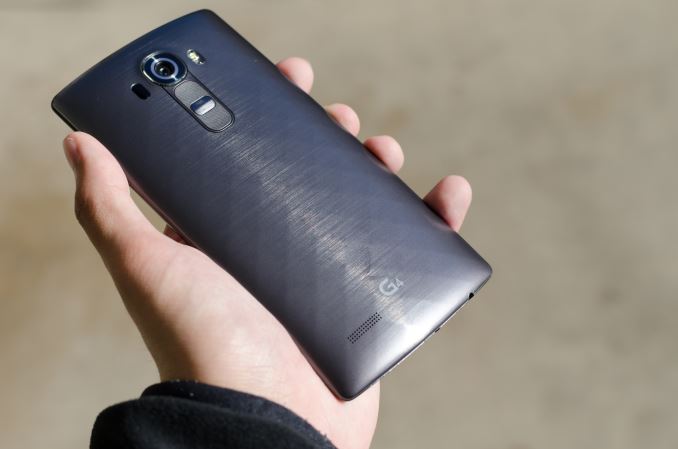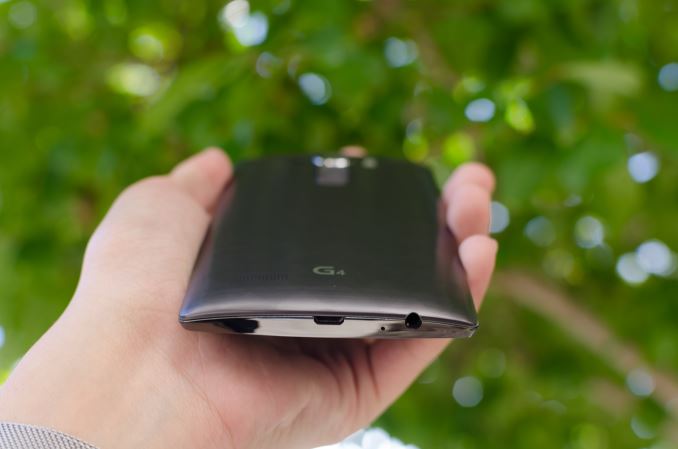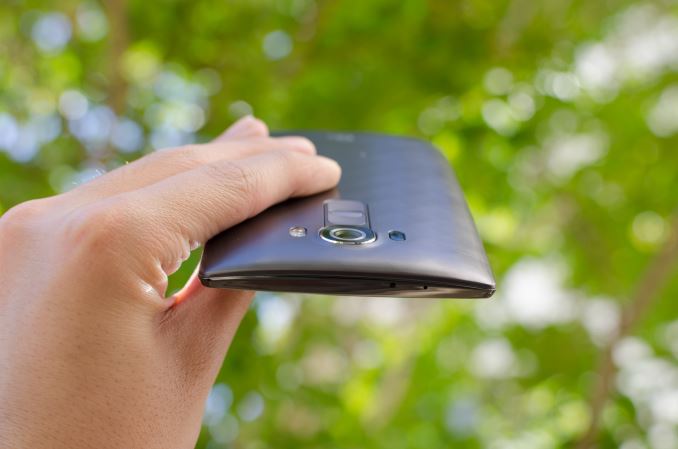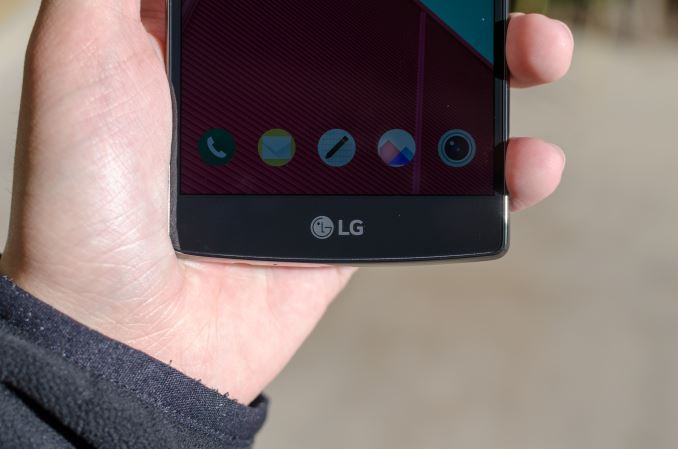The LG G4 Review
by Joshua Ho on July 30, 2015 10:00 AM EST- Posted in
- Smartphones
- Qualcomm
- LG
- Mobile
- Snapdragon 808
- LG G4
Final Words
LG’s flagship smartphone has, in my opinion, always represented the culmination of what LG as a conglomerate could in some sense achieve. LG’s G flagships have often shipped with LG Chem batteries, LG Innotek camera modules, LG Display LCDs, and LG Mobile’s design and integration. In order to really pass judgment on this effort as a whole, we have to re-examine each piece of the G4 to really understand the whole of the device.
Probably the first and most logical place to start is the design. Although LG hasn’t gone for aluminum unibody design or a glass back, the G4 manages to have some real authenticity in its design as they don’t seem to make any real attempt to dress up the fact that the phone is plastic. The glossy sides are a bit irritating, but overall I don’t have a lot to complain about here. The leather backs also help a great deal with improving in-hand feel for those that don’t want a plastic back cover. The removable back makes switching these covers out pretty easy, and also allows for removable battery and microSD, two features that can make or break a purchase for those that need them.
The squared-off design does make it harder to use with one hand though, and as a result this phone is really more like a small phablet than a big phone. I suspect that people would be happier with one phone at 68-70 mm wide, and another at 78-80mm wide with appropriate height and thickness as this would mean that there is choice between a phone that can be easily used with one hand and another that is designed for two hands but still easily portable.
Moving past design, the display of the G4 is fully capable of being incredible. The gamut of the display is wide, the brightness is high, the display controller supports panel self-refresh/GRAM, the resolution is great, and contrast is also incredible for an LCD. However, the calibration is rather disappointing as it’s just too blue, and colors are generally too saturated and somewhat cold. Here, I think LG really needs to consider either solely targeting an accurate sRGB profile, or allowing a toggle between a vivid mode and an accurate mode or something similar.
And to be fair to LG, this display is still a major step forward from the G3, as the sharpening effects on the G3 made it very hard to use the G3 for extended periods of time, but I still think LG needs to focus more on accurate display. I do think there is value to 1440p in a 5.5” display, but below 5 inches it doesn’t make sense to use 1440p as the One M7’s display is still comparable to the G4 in terms of perceived resolution for me. I still don’t think resolution is all that important at this point though, as 1080p is sufficient even for a 5.5” display.
Probably one of the most discussed features of the G4 this year though is the camera. While the upgrade in camera quality from the G2 to the G3 was relatively minor, the jump this year is rather significant. Low light performance has dramatically improved, as has the camera UI, camera features, camera latency, and camera post-processing. To that end this camera is probably one of the best I’ve ever used in an Android smartphone.
Looking at the camera holistically, I would still give a slight edge to the G4 over the Galaxy S6 due to my personal emphasis on still image quality over video. If the GS6 is roughly equal to or slightly worse than the iPhone 6 Plus as a camera overall, I would say the G4 is roughly equal to the iPhone 6 Plus, as photo quality, shot latency, 4K video, and camera UI are arguably superior, but the iPhone 6 Plus has better focus latency in most conditions, better slow motion video, better 1080p video, 1080p60 video, and arguably more natural image processing. With some less aggressive noise reduction on the GS6 and a better camera UI, I suspect that the G4 and Galaxy S6 would end up in a dead heat, which is great to see after the rather disappointing cameras of 2014 Android flagships.
I’m also not going to dwell too much on battery life other than to say that LG has done a great job here improving over the LG G3. With the new display and Snapdragon 808, LG manages to dramatically improve battery life to the point that it’s comparable to something like the Galaxy Note 4 on WiFi, and with LTE it seems that Qualcomm’s modem expertise has definitely paid off as only the OnePlus One and devices like the Ascend Mate 2 really edge out the G4. Battery efficiency on compute-heavy tasks does fall slightly short of the Galaxy S6, but the larger battery helps to even things out for the most part, and sustained performance is much better than what we see on the Snapdragon 810. Charge time is also acceptable, but not necessarily as ridiculously quick with the stock charger.
Overall, system performance is also noticeably better than the Snapdragon 810 devices that we’ve tested so far in pretty much everything but the GPU, and the G4 only slightly trails the Galaxy S6 in most situations which is a bit of a surprise. If you aren’t too concerned about intense emulators or similar tasks that really need all the GPU and CPU power possible, the G4 should deliver more than enough power for everyday tasks that most people will use their smartphones for.
Moving on to somewhat more subjective territory, LG’s UI is surprisingly good, but in need of some polish. I feel like a lot of people strongly criticize LG’s UI and place it around the level of previous iterations of TouchWiz, but in practice I’ve actually found a lot of relatively smart UI features that are well-integrated into the phone. For example, it’s easy to check the time and notifications simply by swiping down on the display while the screen is off. KnockOn is also a smart feature, although not necessarily new. In general, apps are relatively well-designed, and I have all the functionality that I’m expecting from these apps. LG just needs to continue working on optimizing their UI for better performance and also focusing on better design cohesiveness with AOSP UI and general design consistency.
Finally, looking at the bigger picture, let's talk about how the LG G4 fares versus its competition. If we look at the current Android smartphones as competitors, as far as flagship phones go I feel that the Galaxy S6 is really the only other phone up to the G4's caliber, and by extension the best point of comparison. Relative to the Galaxy S6, you lose the ability to use the phone with one hand comfortably, and the design is arguably not as nice to hold in the hand, but you gain a removable battery and microSD card slot, along with a larger display. The SoC in the G4 is definitely not as good as the one in the Galaxy S6, but the larger battery compensates for it in most situations so battery life is about the same.
Meanwhile judging things from a visual point of view, the display of the G4 isn’t as good as a whole compared to the Galaxy S6 if you care about color accuracy, but if you don’t the two are effectively equals. The camera is slightly better on the G4, but the differences are mostly a difference of post-processing rather than anything else. The UIs are almost neck and neck, and completely subjective in terms of user preference.
Ultimately when it comes to comparing the G4 to the Galaxy S6, I think that there are clearly different audiences that would feel very strongly that they would want one or the other. But at the end of the day it’s really hard for me to decide which one is better. I suspect that the real difference in the end simply comes down to size.














84 Comments
View All Comments
Impulses - Friday, July 31, 2015 - link
I get that Anandtech is US centric to an extent, but with a lot of people in the US opting for contract-less plans to save money it might make sense to start factoring price into the equation when it comes to flagships... I wouldn't even have a clue if there are any significant differences, last phone I bought was the N5 and that was the first and only phone I've paid for in full w/o subsidy.tuxRoller - Thursday, July 30, 2015 - link
Such a shame Qualcomm didn't make the 808's cores faster (say, 2GHz) and equip it with at least the adreno 420.I understand why they didn't, and given the 810's design wins, their strategy clearly worked, but it still leads me to wonder "what if".
I wonder what's going on with their implementation of cci(assuming that's the culprit)? They've had enough experience by now to know how to properly implement a standard two tier cache system.
Buk Lau - Thursday, July 30, 2015 - link
if they boosted the 808 to higher clocks, which I'm sure they could since all they've been doing since 801 is just overclocking the chips, that would give OEMs more incentives to choose the 808 over the 810. let's say this, if the 808 comes higher clocked A57s and adreno 420, how many people do you think would even consider the 810? After all the 810 is much more profitable than 808. It just sucks to see how many OEMs got burnt by 810.in a sense, OEMs only have themselves to blame rather than qualcomm for having to release junk phones all over this year. back in the old days qualcomm's SoCs suffered even worse overheating and performance and yet OEMs still persist to use their stuff, simply because they offered an integrated modem
if they didn't spoil qualcomm so much back then, there wouldn't be so little choices in the SoC market with players like Texas instruments and others competing against qualcomm.
Impulses - Friday, July 31, 2015 - link
Don't NVidia and Intel have integrated modems at this point? They're still making SoCs, as is Samsung, seems there's still plenty of choices... We lost what, TI and Sony? I must be forgetting others, I remember lamenting the contracting SoC market too...whiteiphoneproblems - Thursday, July 30, 2015 - link
"It seems that these improvements have been enabled with the use of photoalignment technology, which shares similarities with photolithography but attempts to induce anisotropy in a photoresist analogue on a glass substrate..."Well, you won't see a sentence like that in Gizmodo.com...!
zodiacfml - Friday, July 31, 2015 - link
Another excellent review. Thanks. I also love it when you include many other phones such as the Nexus 5 and Moto G in the benchmarks.Good thing the dual core has real life advantages over the 810. The 8 core spec is nothing but marketing advantage.
As a camera enthusiast, I would also love the manual controls. Yet, I don't think I would use it too often as the control you could get doesn't add to much to the image quality. I mean, using HDR mode pretty much fixes the IQ weaknesses of smartphone cameras to dedicated, larger cameras. The worse noise in the corners probably indicates vignetting with the lenses, only it is fixed/lifted in processing.
Few months after release, the G4 is now slightly cheaper compared to S6 yet I don't think it is enough. The S6 still has a lot better value to G4 because of the display and SoC. The external build quality and video specs makes the S6 even higher. The only fault of the S6 is the small battery they included with it. The Note 5 surely will fix that but it's going to be much more expensive.
Mugur - Friday, July 31, 2015 - link
Nice review, although some phrases were a bit too strange for my taste..."One of the major points of emphasis for us in the smartphone space continues to be display, as even though you can replace a display on a phone, the only real reason to do so is if you shatter the glass cover of the display."
And, of course, I fully disagree with the claim that "the GS6 is roughly equal to or slightly worse than the iPhone 6 Plus as a camera overall". In my personal experience, the S6 camera is the best all-around camera, at least with auto settings and I'm not a Samsung fan...
victorson - Friday, July 31, 2015 - link
Hey Josh! You're fired.neo_1221 - Friday, July 31, 2015 - link
I got a laugh out of that too. :Dmpokwsths - Friday, July 31, 2015 - link
These ridiculous nand/storage benchmarks...